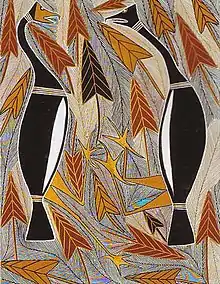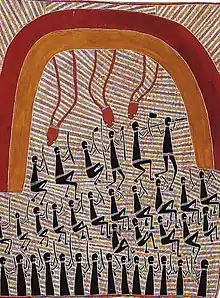George Milpurrurru
George Milpurrurru (1934–1998) was an Australian Aboriginal artist known for his bark paintings.
George Milpurrurru | |
|---|---|
| Born | 1934 |
| Died | 1998 |
| Parent(s) | Ngulmarrmar |
| Relatives | Charlie Djurritjni (brother), Robyn Djunginy (sister), Dorothy Djukulul (sister), Gladys Getjpulu (daughter) |
Biography
Milpurrurru was born and raised in Central Arnhem land, specifically Ganalbingu land, where he learned his artistry.[1] He comes from a family of artists. He is the son of Dick Ngulmarrmar, who taught him the art of bark painting, and the sister of Dorothy Djukulul, who is also a highly respected bark painter.[2] He is a part of the Gurrumba Gurrumba clan, which means “a flock of geese”.[2] The traditions, styles, and surroundings of his clan provided much inspiration when it came to his bark paintings. Milpurrurru has a daughter, Gladys Getjpulu, who is also an artist.[2] As one of the Ramingining artists, Milpurrurru was inspired by the narratives of his home, branching out from the style taught by his father.[3] For him the space used is juxtaposed between stark forefront and background solid spaces, creating dimension with bare bark.[3]
Career

Milpurrurru first started his career as an artist by selling his work in the 1970s to art dealer Dorothy Bennett.[4] He individualized his work by adding innovative styles to the traditional styles and techniques of his clan such as combining the cross hatching technique of Western Arnhem Land with the Eastern technique of depicting plain figures against black backgrounds.[4][1] His most common theme amongst his paintings is the Magpie Geese.[4]
He was one of the first indigenous artists to exhibit at the Biennale of Sydney in 1979.[5] Along with Johnny Bonguwuy and David Malangi, Milpurrurru took part in the 1979 Sydney event, A European Dialogue, in which their art was first broadcast to a wider audience, the larger part of metropolitan Australia.[6]
In 1985, he showed his first solo exhibition at the Aboriginal Arts Australia Gallery in Sydney.[4] Following his solo exhibition, he showed for a second time at the Biennale of Sydney.[4] His work gained global recognition when he participated in several major international exhibitions, like Aratjara, touring Europe from 1993 to 1994.[5] Milpurrurru was also a senior contributing artist in The Aboriginal Memorial at the National Gallery of Canberra and the first aboriginal artist with a solo retrospective exhibition at the National Gallery of Australia.[4][7] He also played an integral role in the lawsuit dealing with the application of copyright to indigenous arts.[1][8]
Collections

Milpurruruu's work is held in the permanent collections of the following:
Aboriginal Memorial
The Aboriginal Memorial is a memorial constructed by twenty men of Ramingining and is meant to serve as a reminder of the Aboriginal peoples' place within Australia, in response to the European nationalization.[11] It is made up of 200 decorated hollow log coffins and was conceived by Djon (John) Mundine in 1987–88 and realised by 43 artists, one of which was Milpurruruu. Milpurrurru's work, representing the Ganalbingu people in the upper right bank of the memorial, is intended to demonstrate distinction of place through the depiction of waterlilies and cormorants.[11]:647
References
- "George Milpurrurru, b. 1934". National Portrait Gallery people. Retrieved 4 May 2020.
- "The Aboriginal Memorial". nga.gov.au. Retrieved 4 May 2020.
- "George Milpurrurru and David Malangi". Artlink Magazine. Retrieved 31 March 2020.
- "George Milpurrurru - Artists Profile - Cooee Art". www.cooeeart.com.au. Retrieved 4 May 2020.
- "George Milpurrurru". National Museum of Australia. Retrieved 4 May 2020.
- Mundane, Djon (1999). ""The Land is Full of Signs," in Art from the Land: Dialogues with the Kluge-Ruhe Collection of Australian Aboriginal Art"". University of Virginia Press: 85–120.
- National Gallery of Australia. (1993). The art of George Milpurrurru. Canberra: National Gallery of Australia. ISBN 978-0-642-13083-9.
- Janke, Terri (February 1995). "Copyright: The Carpets Case". AustLII. 20:1.
- "Untitled (Dupun Ceremony) | George Milpurrurru~Ganalbingu". National Gallery of Victoria, Melbourne. Retrieved 31 March 2020.
- "Garrtjambal - kangaroo, (1985) by George Milpurrurru". Art Gallery of New South Wales. Retrieved 31 March 2020.
- Smith, Terry (2001). "Public Art between Cultures: The "Aboriginal Memorial," Aboriginality, and Nationality in Australia". Critical Inquiry. 27 (4): 629–661. doi:10.1086/449025. ISSN 0093-1896. JSTOR 1344317.